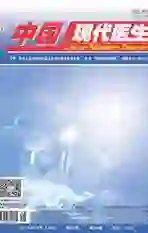ACCF与ACDF治疗双节段脊髓型颈椎病的中期疗效及并发症随访分析
2018-01-05李海东张强华何守玉
李海东 张强华 何守玉
[摘要] 目的 探討前路椎体次全切钛网植骨融合内固定术(anterior cervical corpectomy and fusion,ACCF)与前路椎间盘切除Cage 植骨融合内固定术(anterior cervical discectomy and fusion,ACDF)治疗相邻双节段脊髓型颈椎病的中期疗效及并发症发生情况。 方法 分析2010年1月~2014年12月期间共252例相邻双节段脊髓型颈椎病行颈前路减压融合内固定患者的临床资料,分为两组,ACCF组137例,ACDF组115例。比较两组患者手术时间、出血量、术前及术后日本矫形外科协会(Japanese orthopaedic association,JOA)评分、颈椎残障功能指数(Neck disability index,NDI)以及随访期间出现的并发症情况。 结果 两组人群手术时间及术中出血量无明显差异(P<0.05);随访过程中失访25例,其余均术后随访36个月。末次随访时,ACCF组患者JOA、NDI指数分别为(14.56±1.89)分,(6.26±1.29);ACDF组JOA、NDI指数分别为(14.28±1.78)分,(6.30±1.12),均较术前明显改善,但组间差异无统计学意义(P<0.05)。共有61例在术后36个月内出现并发症,发生率26.87%,其中ACCF组33例(包括吞咽不适2例,内固定相关并发症1例,邻近节段退变26例,融合失败1例,C5神经根麻痹3例);ACDF组28例(伤口感染1例,吞咽不适1例,内固定相关并发症1例,邻近节段退变23例,融合失败1例,C5神经根麻痹1例)。结论 两组手术方案在邻近双节段颈椎病的治疗上中期临床效果相当。ACDF组并发症发生率略高(26.9% vs 26.6%),但无明显统计学差异。ACDF组邻近节段退变发生率稍高,而ACCF组C5神经根麻痹的发生率稍高。
[关键词] 脊髓型颈椎病;前路手术;中期疗效;并发症
[中图分类号] R687.3 [文献标识码] A [文章编号] 1673-9701(2018)28-0018-05
[Abstract] Objective To analyze and compare the mid-term efficacy and complications of anterior cervical corpectomy and fusion(ACCF) and anterior cervical discectomy and fusion (ACDF) in the treatment of adjacent dual-segmental cervical spondylotic myelopathy. Methods The clinical data of 252 patients with adjacent dual-segmental cervical spondylotic myelopathy undergoing anterior cervical decompression and fusion internal fixation from January 2010 to December 2014 were analyzed and the patients were divided into two groups. There were 137 patients in ACCF group and 115 patients in ACDF group. The operation time, amount of blood loss, preoperative and postoperative Japanese orthopaedic association(JOA) scores, and neck disability index(NDI), as well as the complications that occurred during follow-up visit were compared between the two groups. Results There was no significant difference in operation time and intraoperative blood loss between the two groups(P<0.05); during follow-up visit, 25 patients were lost to follow-up, and the rest were followed up for 36 months after surgery. At the final follow-up visit, the JOD and NDI index in the ACCF group were (14.56±1.89) and (6.26±1.29) respectively; the JOA and NDI index in the ACDF group were (14.28±1.78) and(6.30±1.12) respectively. All of them were significantly improved compared before surgery(P<0.05), but there was no statistically significant difference between the two groups. A total of 61 patients had complications within 36 months after operation, with the incidence rate of 26.87%. There were 33 cases in ACCF group (including 2 cases of swallowing discomfort, 1 case of internal fixation-related complications, 26 cases of adjacent segment degeneration, 1 case of fusion failure, and 3 cases of C5 nerve root palsy). There were 28 patients in the ACDF group (1 case of wound infection, 1 case of swallowing discomfort, 1 case of internal fixation-related complications, 23 cases of adjacent segment degeneration, 1 case of fusion failure, and 1 case of C5 nerve root palsy). Conclusion The two groups of surgical plans have similar clinical effects in the treatment of adjacent dual-segmental cervical spondylosis. The incidence rate of complications in the ACDF group is slightly higher(26.9% vs 26.6%), but there is no statistically significant difference. The incidence rate of adjacent segmental degeneration in the ACDF group is slightly higher, while the incidence rate of C5 nerve root palsy in the ACCF group is slightly higher.
[Key words] Cervical spondylotic myelopathy; Anterior approach; Mid-term efficacy; Complications
Smith于1958年首次提出颈椎前路减压植骨融合手术,经过几十年的发展和改进,目前该手术被广泛运用于治疗颈椎退行性病变、肿瘤、外伤及感染性病变。其中,ACCF和ACDF是临床上使用最多的两种颈椎前路减压手术[1-3]。这两种术式具有直接解除致压物对脊髓的压迫、预防因脊髓后移而产生的神经根牵张性损害、术后疗效稳定等优势。ACDF手术往往局限于单纯的颈椎间盘突出导致的脊髓压迫患者,而当椎体后缘层面出现巨大骨赘、后纵韧带骨化压迫脊髓或同时存在椎管狭窄时,因ACCF减压范围更大,植骨更充分而被广泛采用[4-5]。对于双节段脊髓型颈椎病的患者,往往同时存在椎间盘退变突出、椎体后缘骨赘或后纵韧带骨化等问题,如何实行精确而又彻底的减压,减少不必要的损伤,快速促进康复一直是研究热点,但目前尚无统一的治疗方案。本研究针对相邻双节段脊髓型颈椎病的患者,分别采用ACDF或ACCF术式,对两组术后中期疗效及并发症情况进行分析比较,为该类患者选择更合适的治疗方法提供依据。
1 资料与方法
1.1 一般资料
选择2010年1月~2014年12月在我院行颈椎前路手术治疗的相邻双节段脊髓型颈椎病的患者资料进行分析。其中男116例,女136例,共252例;平均年龄53.8岁(32~76岁)。纳入标准:患者存在典型的脊髓型颈椎病症状及体征,经正规保守治疗6个月无效,且患者病史、体征及影像学资料证实存在手术指征。排除标准:二次手术、脊柱创伤、感染、肿瘤、畸形、颈椎后纵韧带骨化(ossification of posterior longitudinal ligament,OPLL)、先天性椎管狭窄。根据患者入院先后顺序随机将患者分为两组:其中ACCF组137例,男65例,女72例,平均年龄54.4岁;ACDF组115例,其中男51例,女64例,平均年龄54.6岁。两组的年龄、性别、手术节段等指标基线资料一致,差异无统计学意义(P>0.05),具有可比性。见表1。
1.2 方法
A组采用标准ACDF法,减压过程中首先切除病变节段的颈椎椎间盘,刮匙刮除椎体后缘骨赘,切除后纵韧带,处理终板后在cage中填充术中切除的碎骨,适当撑开椎间隙后置人工cage。椎体前方以颈前路钢板固定(图1);B组采用标准ACCF法,首先摘除病变的两个节段椎间盘,切除责任椎体,勾刀切开后纵韧带,处理椎体后缘骨赘,选取合适长度钛网,将减压过程中切除的碎骨填入钛网,将钛网置入骨槽,撑开恢复颈椎高度,以颈前路钢板固定(图2)。手术器械均由美敦力公司提供,手术均由同一主刀医生完成。
所有患者术后24 h停抗生素,术后第1天可下地行走,术后48 h内拔除引流管。嘱咐患者术后颈托制动2个月。
1.3 观察指标
分别记录两组手术患者术中出血量、手术时间;记录患者术前、术后3 d及随访过程中的JOA评分及NDI指数。患者术后3个月、12个月及36个月时进行随访。随访过程中行颈椎正侧位及动力位X线检查,记录随访过程中出现的并发症情况,包括伤口感染、吞咽梗阻感、内固定松动、断裂、临近节段退变(adjacent segment degeneration,ASD)、融合失败及C5神经根麻痹等。植骨融合判断标准:(1)在终板和植骨块之间存在骨桥;(2)屈伸动力位X线片上融合节段无活动度;(3)融合器周围及螺钉周围无透光带表现[6-7]。根据X线Kellgren分级法:0级,关节间隙正常,无骨赘;1级,关节间隙可以变窄,可能有骨赘;2级,关节间隙可以变窄,有明显骨赘;3级,关节间隙明确变窄,中等量骨赘,有硬化性改变;4级,关节间隙明显变窄,大量骨赘,严重硬化性改变。本研究认为邻近节段退变指Kellgren分级≥2级。
1.4 统计学方法
本研究采用SPSS16.0统计软件。计量资料使用(x±s)表示,采用独立样本t检验进行统计分析,以P<0.05为差异有统计学意义。
2 结果
2.1 两组手术情况及术后疗效比较
ACDF组平均手术时间(136.32±30.64)min,ACCF组手术时间(145.42±14.82)min,组间差异无统计学意义(P>0.05);ACDF组平均出血量(61.55±27.4)mL,少于ACCF组(65.48±21.94)mL,但差异亦无统计学意義(P>0.05)。见表2。在随访过程中,ACCF组失访13例,ACDF组失访12例,其余患者均得到随访。ACCF组术后第3天、3个月、1年和3年的JOA评分分别为(9.26±1.39)分、(11.26±1.23)分、(14.26±1.89)分、14.56±1.89)分,较术前明显好转,差异有统计学意义(P<0.05);ACDF组术后第3天、3个月、1年和3年的JOA评分分别(9.10±1.32)分、(11.30±1.43)分、(14.30±1.99)分、(14.28±1.78)分,较术前明显好转,差异有统计学意义(P<0.05);但组间同时间段比较差异无统计学意义(P>0.05)。见表3。ACCF组术后第3天、3个月、1年和3年的NDI指数分别为(17.26±2.89)、(11.63±1.89)、(10.26±1.18)、(6.26±1.29),较术前明显好转,差异有统计学意义(P<0.05);ACDF组术后同时段随访时的NDI指数分别为(17.30±2.99)、(12.30±1.99)、(10.30±1.29)、(6.30±1.12),均较术前明显好转,差异有统计学意义(P<0.05);但组间同时间段比较差异无统计学意义(P>0.05)。见表4。
2.2 两组术后并发症比较
在随访过程中,ACCF组失访13例,ACDF组失访12例,其余患者均得到随访。在所有得到随访的227例患者中,61例出现中期并发症(ACCF组33例,ACDF组28例),发生率达26.87%,详见表5。两组人群在伤口情况、内固定相关并发症及融合率等方面无明显差异(P>0.05);ASD发生率ACDF组略高,但无统计学差异(22.33% vs 20.97%);而C5神经根麻痹发生率ACCF组高于ACDF组,但亦无统计学意义(P>0.05)。ASD为本研究的主要中期并发症,发生率为21.59%。ACCF组中22例出现上位ASD,4例出现下位ASD;ACDF组中21例出现上位ASD,2例出现下位ASD。本研究中3例ASD患者出现神经根及脊髓压迫症状,经口服消炎镇痛药、联合激素及营养神经等对症处理,2例症状缓解,1例经保守治疗无效后行Ⅱ期翻修手术。两组人群组间ASD分布无统计学差异(P>0.05)。
3 讨论
颈椎前路手术不仅能够对压迫脊髓的病变组织进行直接切除,减压效果更加明确,而且能够进行椎间植骨,恢复颈椎前凸,重建病变节段的稳定性,是目前颈椎病外科治疗的一种主流术式。对于连续性双节段或多节段脊髓型颈椎病,经前路减压的主要方式有ACDF及ACCF两种手术方式,均可以从前方直接去除致压物,大多数文献报道神经功能恢复效果满意[8-9]。
椎体次全切手术操作时不仅术野开阔,有利于充分减压及术中脊髓损伤风险性较低,而且术中切除的碎骨粒又可作为自体植骨材料,术后植骨融合率高而得到许多学者的青睐[10-11]。有的学者认为ACDF术中减压过程中无须处理后纵韧带,通过椎间隙撑开固定融合能够取得脊髓间接减压目的,并且能够减少术中脊髓损伤的风险[12]。Bohlman等[12]研究报道了17例脊髓型颈椎病患者,采用椎间盘摘除椎间融合术(ACDF术),术中既不去除骨赘也不去除后纵韧带,术后16例患者取得优和良的临床效果,优良率达94%。Kadoya等[13]报道了手术治疗43例脊髓型颈椎病患者,术中在显微镜下常规去除椎体骨赘及后纵韧带,无1例出现医源性脊髓损伤。Oh在一项31例的回顾性研究中发现,ACCF和ACDF治疗两节段脊髓型颈椎病临床疗效相似,但在患者合并发育性椎管狭窄、椎体后缘合并OPLL、终板后缘大块骨赘、大块椎间盘脱出椎体后缘时应当首选ACCF[14]。Liu等[15]在一项5年的随访研究中发现,ACCF和ACDF在两节段脊髓型颈椎病的治疗上均具有良好的临床疗效和较高的术后融合率,但是ACDF手术具有出血少、手术时间短、颈椎生理前凸恢复好等优势[15]。根据我们的经验,术中减压常规切除增生的骨赘及后纵韧带,手术难度并不增加,不会增加脊髓损伤的风险。本研究中,ACDF组手术时间更短、术中出血更少,但并无显著差异;患者术后随访时VAS及NDI指数较术前明显改善,但组间无明显差异,手术效果相当。
尽管前路手术是治疗脊髓型颈椎病的主流术式,但其也不可避免地存在诸多问题,比如更加容易出现脑脊液漏、神经损伤、食管瘘、吞咽困难、邻近节段退变等并发症。在本研究随访期间共有61例患者出现各种并发症,其中ACCF组33例,ACDF组28例,总发生率26.87%,包括吞咽困难、C5神经根麻痹、ASD及切口感染等。两组术后并发症无明显统计学差异。本研究中,ASD是两组术后主要的并发症,发生率分别为20.97%和22.33%。
文献报道颈椎前路减压融合内固定术后中远期主要的并发症为ASD的发生,包括椎体前后方骨赘形成、椎间失稳、椎间隙变窄、椎间盘退变突出等,其发生率达50%~60%[16]。目前,ASD的发生机制不完全清楚,大部分学者认为颈椎融合术后运动单元减少,运动范围减少,运动方式改变,导致局部节段应力集中,是造成邻近节段退变的主要原因[17]。Olsewski等[18]研究显示,术前患者年龄越大,术后ASD的可能性越大,Song等[19]指出年龄导致的自然退变甚于融合本身对ASD发展的影响。目前大多数研究认为融合节段数是ASD的影响因素之一。Chung等[20]认为融合节段越多将更有可能促进ASD的发展。Song等[21]研究发现当颈椎管率<0.70时更容易发生ASD,椎管的大小可能会影响ASD的发展。本研究ASD发生率为21.59%,比较低的原因可能与随访时间不够长有关。ACCF组26例出现ASD,ACDF组23例出现ASD,差异无统计学意义,因此我们有理由认为相邻双节段颈椎病术后ASD的发生与手术方式无关,可能与患者的年龄、生活方式、颈椎自然退变等有关。
总之,在相鄰双节段颈椎病的治疗上,ACCF和ACDF中期手术效果相当,ACDF术后中期并发症稍高,但组间差异无统计学意义,而C5神经根麻痹的发生率ACCF组高于ACDF组。我们在诊治相邻双节段颈椎病这一特殊疾病时,应根据脊髓致压物的性质、来源、部位及大小等多方面综合考虑,选择合理的手术方案,规范化手术操作,并辅以科学周密的围手术期护理,降低中长期并发症。
[参考文献]
[1] Park DH,Ramakrishnan P,Cho TH,et al. Effect of lower two-level anterior cervical fusion on the superior adjacent level[J]. J Neurosurg Spine,2007,7(3):336-340.
[2] Matz PG,Holly LT,Mummaneni PV,et al. Anterior cervical surgery for the treatment of cervical degenerative myelopathy[J]. J Neurosurg Spine,2009,11(2):170-173.
[3] Gao R,Yang L,Chen H,et al. Long term results of anterior corpectomy and fusion for cervical spondylotic myelopathy[J].PLoS One,2012,7(4):e34811.
[4] Han YC,Liu ZQ,Wang SJ,et al. Is anterior cervical discectomy and fusion superior to corpectomy and fusion for treatment of multilevel cervical spondylotic myelopathy? A systemic review and meta-analysis[J].PLoS One,2014, 9(1):e87191.
[5] Park Y,Maeda T,Cho W,et al. Comparison of anterior cervical fusion after two-level discectomy or single-level corpectomy:Sagittal alignment,cervical lordosis,graft collapse,and adjacent-level ossification[J]. Spine J,2010,10(3):193-199.
[6] Chang SW,Kakarla UK,Maughan PH,et al. Four-level anterior cervical discectomy and fusion with plate fixation:Radiographic and clinical results[J]. Neurosurgery,2010,66(4):639-647.
[7] Papadopoulos EC,Huang RC,Girardi FP,et al.Three-level anterior cervical disceetomy and fusion with plate fixation:Radiographic and clinical resuhs[J]. Spine,2006, 31(8):897-902.
[8] Hwang SL,Lee KS,Su YF,et al. Anterior corpectomy with iliac bone fusion or discectomy with interbody titanium cage fusion for multilevel cervical degenerated disc disease[J].J Spinal Disord Tech,2007,20(8):565-570.
[9] Topuz K,Colak A,Kaya S,et al. Two-level contiguous cervical disc disease treated with peek cages packed with demineralized bone matrix:Results of 3-year follow-up[J]. Eur Spine J,2009,18(2):238-243.
[10] Swank M,Lowery G,Bhat A.Improved arthrodesis with strut-grafting and instrumentation:Multi-level interbody grafting or strut graft reconstruction[J]. Eur Spine J,1997, 6(2):138-143.
[11] Edwards CC 2nd,Riew KD,Anderson PA,et al.Cervical myelopathy:Current diagnostic and treatment strategies[J].Spine J,2003,3(1):68-81.
[12] Bohlman HH. Cervical spondylosis with moderate to severe myelopathy:A report of 17 cases treated by R obinson anterior cervical discectomy and fusion[J]. Spine,1977, 2(6):151-162.
[13] Kadoya S,Nakamura T,Kwar R. A microsurgical anterior osteophytectomy for cervical spondylotic myelopathy[J].Spine,1984,9(5):437-441.
[14] Oh MC,Zhang HY.Two-level anterior cervical discectomy versus one-level corpectomy in cervical spondylotic myelopathy[J].Spine(Phila Pa 1976),2009,34(7):692-696.
[15] Liu J,Chen X,Liu,et al. Anterior cervical discectomy and fusion versus corpectomy and fusion in treating two-level adjacent cervical spondylotic myelopathy:A minimum 5-year follow-up study[J]. Arch Orthop Trauma Surg,2015,135(2):149-153.
[16] Heino K,Michael K,David H,et al. Integrated outcome assessment after anterior cervical discectomy and fusion:Myelocompression but not adjacent instability after patient-reported quality of life and cervical spine symptoms[J].Spine,2004,29(22):2501-2509.
[17] Lee S,Harris KG,Goel VK,et al. Spinal motion after cervical fusion. In vivo assessment with roentgen stereophotogrammetry[J]. Spine,1994,19(20):2336-2342.
[18] Olsewski J.Incidence of adjacent segment degeneration in the cervical spine[J]. Spine J,2011,18(8):72-73.
[19] Song KJ,Choi BW,Jeon TS,et al. Adjacent segment degenerative disease:Is it due to disease progression or a fusion-associated phenomenon? comparison between segments adjacent to the fused and non-fused segments[J]. Eur spine J,2011,20(11)1940-1945.
[20] Chung JY,Kim SK,Jung ST,et al. Clinical adjacent-segment pathology after anterior cervical discectomy and fusion:Result after a minimum of 10-year follow-up[J]. Spine J,2014,14(10):2290-2298.
[21] Song JS,Choi BW,Song KJ. Risk factors for the development of adjacent segment disease following anterior cervical arthrodesis for degenerative cervical disease:Comparative between fusion methods[J]. J Clin Neurosci,2014, 21(5):794-798.
(收稿日期:2018-03-24)
